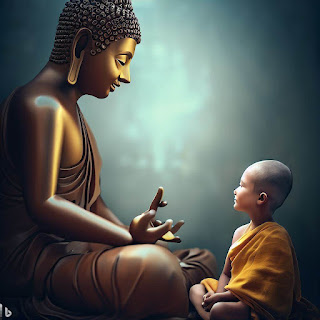Once there was a rich man in Savatthi who had a young son named Pandita. When Pandita was only seven years old, he became a samanera, a novice monk. One day, while he was accompanying Thera Sariputta on an alms round, he noticed some farmers directing water into their fields. Curious, he asked the thera if water, which has no consciousness, could be guided wherever one wanted. The thera replied that indeed, water could be guided as desired.
 |
| Novice Monk |
As they continued their walk, Pandita saw fletchers heating their arrows with fire to straighten them and carpenters cutting and shaping timber. These observations made him reflect on the fact that if water, bamboo, and timber, which lack consciousness, could be directed and transformed, then as a person with consciousness, he should be capable of taming his own mind and practicing meditation.
Filled with this realization, Pandita asked the thera for permission to return to his room in the monastery. There, he wholeheartedly and diligently focused on his meditation, specifically contemplating the body. The devas, including Sakka, aided him by ensuring a quiet and peaceful environment. Before mealtime, Pandita achieved the stage of Anagami Fruition, a high level of spiritual attainment.
Meanwhile, Thera Sariputta was on his way to bring food to Pandita. However, the Buddha, using his supernatural abilities, saw that Pandita had attained Anagami Fruition and was on the verge of attaining arahatship, the highest level of enlightenment. To allow Pandita to achieve this milestone undisturbed, the Buddha intercepted Sariputta at the door and engaged him in conversation. During their discussion, Pandita reached the state of arahatship. Thus, on the eighth day after becoming a novice, Pandita became an arahat, a fully enlightened being.
Dhammapada Verse 80
Panditasamanera Vatthu
Udakam hi nayanti nettika
usukara namayanti tejanam
darum namayanti tacchaka
attanam damayanti pandita.
Read More
Subscribe to my blog





